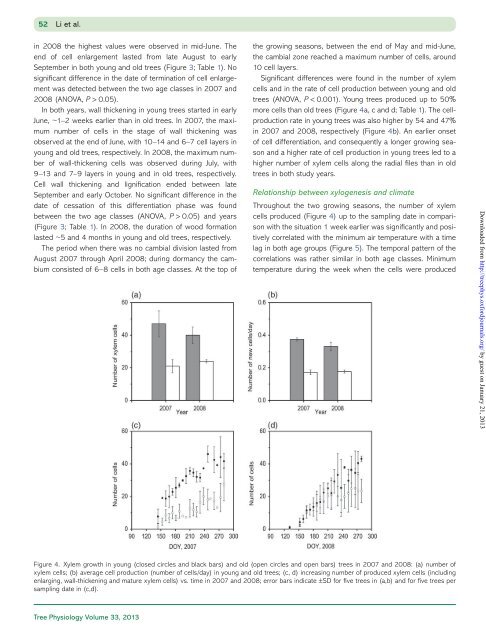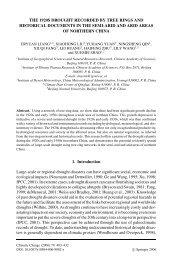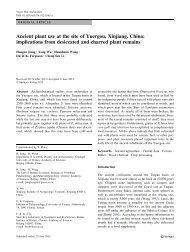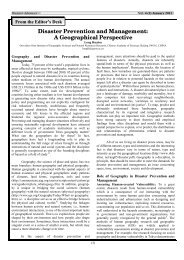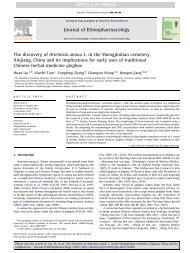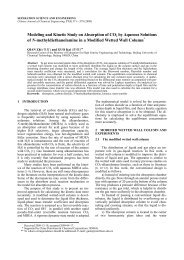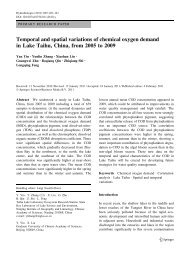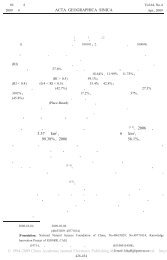AN INTERNATIONAL BOTANICAL JOURNAL
AN INTERNATIONAL BOTANICAL JOURNAL
AN INTERNATIONAL BOTANICAL JOURNAL
Create successful ePaper yourself
Turn your PDF publications into a flip-book with our unique Google optimized e-Paper software.
52 Li et al.<br />
in 2008 the highest values were observed in mid-June. The<br />
end of cell enlargement lasted from late August to early<br />
September in both young and old trees (Figure 3; Table 1). No<br />
significant difference in the date of termination of cell enlargement<br />
was detected between the two age classes in 2007 and<br />
2008 (<strong>AN</strong>OVA, P > 0.05).<br />
In both years, wall thickening in young trees started in early<br />
June, ~1–2 weeks earlier than in old trees. In 2007, the maximum<br />
number of cells in the stage of wall thickening was<br />
observed at the end of June, with 10–14 and 6–7 cell layers in<br />
young and old trees, respectively. In 2008, the maximum number<br />
of wall-thickening cells was observed during July, with<br />
9–13 and 7–9 layers in young and in old trees, respectively.<br />
Cell wall thickening and lignification ended between late<br />
September and early October. No significant difference in the<br />
date of cessation of this differentiation phase was found<br />
between the two age classes (<strong>AN</strong>OVA, P > 0.05) and years<br />
(Figure 3; Table 1). In 2008, the duration of wood formation<br />
lasted ~5 and 4 months in young and old trees, respectively.<br />
The period when there was no cambial division lasted from<br />
August 2007 through April 2008; during dormancy the cambium<br />
consisted of 6–8 cells in both age classes. At the top of<br />
the growing seasons, between the end of May and mid-June,<br />
the cambial zone reached a maximum number of cells, around<br />
10 cell layers.<br />
Significant differences were found in the number of xylem<br />
cells and in the rate of cell production between young and old<br />
trees (<strong>AN</strong>OVA, P < 0.001). Young trees produced up to 50%<br />
more cells than old trees (Figure 4a, c and d; Table 1). The cellproduction<br />
rate in young trees was also higher by 54 and 47%<br />
in 2007 and 2008, respectively (Figure 4b). An earlier onset<br />
of cell differentiation, and consequently a longer growing season<br />
and a higher rate of cell production in young trees led to a<br />
higher number of xylem cells along the radial files than in old<br />
trees in both study years.<br />
Relationship between xylogenesis and climate<br />
Throughout the two growing seasons, the number of xylem<br />
cells produced (Figure 4) up to the sampling date in comparison<br />
with the situation 1 week earlier was significantly and positively<br />
correlated with the minimum air temperature with a time<br />
lag in both age groups (Figure 5). The temporal pattern of the<br />
correlations was rather similar in both age classes. Minimum<br />
temperature during the week when the cells were produced<br />
Downloaded from http://treephys.oxfordjournals.org/ by guest on January 21, 2013<br />
Figure 4. Xylem growth in young (closed circles and black bars) and old (open circles and open bars) trees in 2007 and 2008: (a) number of<br />
xylem cells; (b) average cell production (number of cells/day) in young and old trees; (c, d) increasing number of produced xylem cells (including<br />
enlarging, wall-thickening and mature xylem cells) vs. time in 2007 and 2008; error bars indicate ±SD for five trees in (a,b) and for five trees per<br />
sampling date in (c,d).<br />
Tree Physiology Volume 33, 2013


